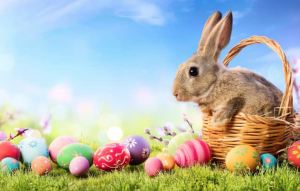Easter Bunny
We all know of the Easter Bunny who brings brightly colored eggs on Easter morning. But how did this custom come to be?
how did this custom come to be?
Easter is thought to be derived from Eostre, a spring goddess of fertility often depicted with a rabbit. In German folklore we find the Osterhase, or Easter Hare, who was said to hatch and hide multicolored eggs for children to discover around their homes and gardens on Easter Sunday. Children would make nests in which this creature could lay its colored eggs.
When the German immigrants brought their traditions to America, the hare became a rabbit. The Easter Bunny’s deliveries expanded to include chocolate and other types of candy and gifts, while decorated baskets replaced nests for the children.
The Easter Bunny and Santa Claus are often compared as they both deliver gifts to children. I remember a talk Rev. Donald gave at Easter one year. He suggested that we should be less like Santa Claus – who deems children naughty or nice to determine who will get a gift and who will get coal – and more like the Easter Bunny who delivers gifts to all children without discrimination.
And how did elaborately decorated eggs become a symbol of Easter in various traditions? Eggs are representative of new life. Also, early churches had their congregations abstain from eggs during Lent, allowing them to be consumed again on Easter. In anticipation, eggs would be colored and adorned to be eaten in celebration on Easter Sunday morning. If you’d like to experiment decorating eggs naturally using common things found around your kitchen, here are some recipes:
Make Natural Easter Egg Dye with Ingredients in Your Kitchen (bhg.com)
This spring, consider embodying the spirit of the Easter Bunny by sharing your gifts to all alike without judgment.
Happy Easter!
–Janet Salese




